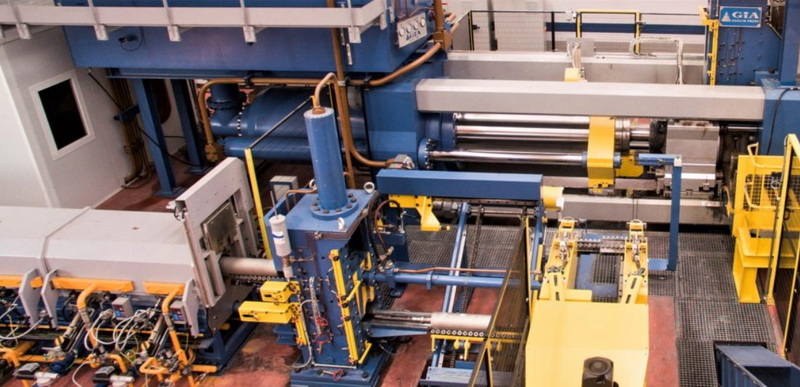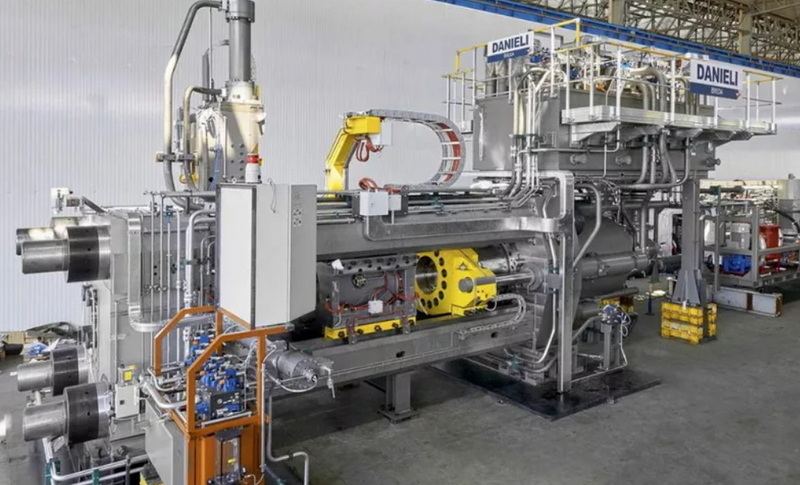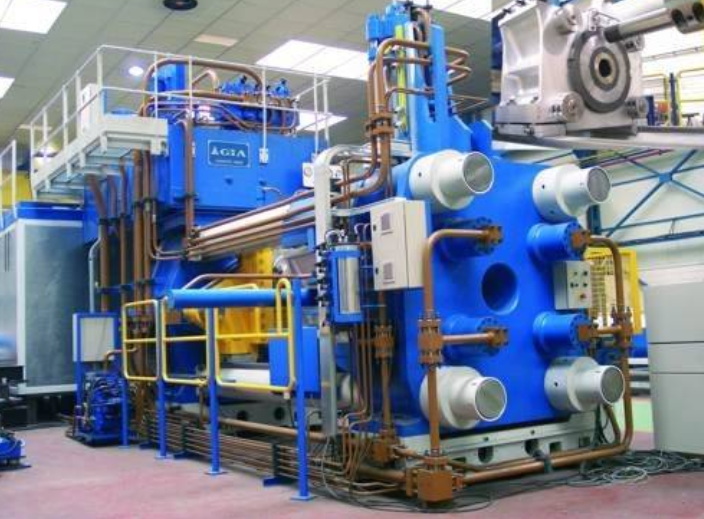Content Menu
● Understanding the Aluminum Extrusion Process
● Tools and Equipment Needed for Changing a Die
● Step-by-Step Guide to Safely Changing a Die
>> 1. Preparation
>> 2. Removing the Existing Die
>> 3. Installing the New Die
>> 4. Post-Installation Checks
● Best Practices for Safe Die Changes
● The Role of Extrusion Dies and Tooling
● Design Considerations for Extrusion Dies
● Maintenance of Aluminum Extrusion Dies
● Advanced Techniques for Efficient Die Changes
>> 1. Quick-Change Die Systems
>> 2. Automated Die Storage and Retrieval
>> 3. Predictive Maintenance
>> 4. Training and Certification Programs
● Environmental Considerations in Die Changing
>> 1. Proper Disposal of Used Dies
>> 2. Energy Efficiency
>> 3. Lubricant Management
>> 4. Waste Reduction
● Safety Protocols for Die Changing
>> 1. Lockout/Tagout Procedures
>> 2. Personal Protective Equipment (PPE)
>> 3. Team Communication
>> 4. Emergency Response Plan
>> 5. Regular Safety Audits
● Troubleshooting Common Issues During Die Changes
>> 1. Misalignment
>> 2. Difficulty in Removing the Old Die
>> 3. Uneven Extrusion After Die Change
>> 4. Excessive Wear on New Die
● Conclusion
● FAQ
>> 1. How often should dies be changed on an aluminum extrusion press?
>> 2. What are the most critical safety precautions when changing a die?
>> 3. Can a single person change a die on an aluminum extrusion press?
>> 4. How can I troubleshoot issues that arise during a die change?
>> 5. What factors affect the lifespan of an extrusion die?
● Citations:
Aluminum extrusion is a vital manufacturing process that shapes aluminum into desired profiles by forcing it through a die. Changing the die on an aluminum extrusion press is a critical operation that requires precision and careful handling to ensure efficiency and product quality. This article provides a comprehensive guide on how to safely change a die on an aluminum extrusion press, detailing the necessary steps, tools, and considerations involved in the process.[1]

Understanding the Aluminum Extrusion Process
Before delving into the die-changing procedure, it's essential to understand the aluminum extrusion process itself. The basic steps include:
1. Die Preparation: The die must be designed and machined to create the desired cross-sectional shape of the aluminum profile.
2. Billet Preheating: The aluminum billet is preheated to enhance its malleability.
3. Extrusion: The heated billet is forced through the die under high pressure, resulting in the formation of the desired profile.
4. Post-Extrusion Handling: After exiting the die, the extruded material undergoes cooling, stretching, cutting, and inspection.[1]
Tools and Equipment Needed for Changing a Die
Changing a die on an aluminum extrusion press requires specific tools and equipment:
- Wrenches and Socket Sets: For loosening and tightening bolts.
- Hoist or Crane: To lift heavy dies safely.
- Die Cart: For transporting dies to and from the press.
- Lubricants: To facilitate easy removal and installation of dies.
- Safety Gear: Including gloves, goggles, and steel-toed boots for protection.[1]
Step-by-Step Guide to Safely Changing a Die
1. Preparation
Before beginning the die change process, follow these preparatory steps:
1. Shut Down the Press: Follow proper shutdown procedures to ensure that the machine is not operational during the die change.
2. Cool Down: Allow the press to cool down if it has been in operation to avoid burns or injuries.
3. Clean Work Area: Clear any debris or materials from around the press to create a safe working environment.[1]
2. Removing the Existing Die
Follow these steps to safely remove the existing die:
1. Loosen Bolts: Use wrenches or socket sets to loosen all bolts securing the existing die in place.
2. Lift Die Out: With assistance from a hoist or crane, carefully lift the old die out of the press. Ensure that all personnel are clear of the lifting path.
3. Inspect Die: Check for wear or damage on the removed die before storing it properly for future use.[1]
3. Installing the New Die
To install the new die safely, follow these steps:
1. Prepare New Die: Inspect the new die for any defects or damage before installation. Clean it thoroughly if necessary.
2. Position Die in Press: Using a hoist or crane, carefully position the new die into place within the extrusion press.
3. Secure Die: Tighten all bolts securely using wrenches or socket sets. Ensure that the die is aligned correctly according to manufacturer specifications.
4. Apply Lubricant: Apply lubricant to any moving parts associated with the die to facilitate smooth operation.[1]
4. Post-Installation Checks
After installing the new die, perform these important checks:
1. Power Up Press: Turn on the extrusion press following proper startup procedures.
2. Run Test Extrusion: Conduct a test run with scrap material to ensure that everything is functioning correctly and that there are no leaks or misalignments.
3. Inspect Output: Examine the extruded profile for quality and consistency. Make adjustments as necessary based on test results.[1]
Best Practices for Safe Die Changes
To ensure safety and efficiency when changing dies on an aluminum extrusion press, follow these best practices:
- Always follow manufacturer guidelines for both equipment operation and die maintenance.
- Regularly inspect dies for wear and tear to prevent unexpected failures during production.
- Maintain proper alignment during installation to ensure consistent product quality.
- Keep detailed records of die usage and maintenance schedules for optimal performance tracking.[1]
The Role of Extrusion Dies and Tooling
The aluminum extrusion process relies heavily on precision-engineered dies that shape aluminum into specific profiles. These dies are critical components that directly influence product quality and manufacturing efficiency.
Types of dies used in aluminum extrusion include:
- Solid Dies: Used for creating solid profiles without voids.
- Hollow Dies: Designed for profiles with one or more voids, such as bridge or spider shapes.
- Semi-Hollow Dies: For profiles with partially enclosed voids, allowing for complex shapes.[1]
Design Considerations for Extrusion Dies
When designing dies for aluminum extrusion, several factors must be considered:
- Effective Bearing Length: This governs metal flow through the die, ensuring uniform exit speeds across different profile sections.
- Thermal Management: Proper cooling systems must be integrated into dies to prevent overheating and ensure consistent material flow.
- Finite Element Analysis (FEA): Utilizing FEA simulations helps predict potential issues related to material flow and structural integrity before manufacturing dies.[1]

Maintenance of Aluminum Extrusion Dies
Proper maintenance of extrusion dies is essential for maximizing their lifespan and ensuring consistent production quality:
1. Regular Inspections: Inspect dies after each production run for signs of wear or damage.
2. Cleaning Protocols: Thoroughly clean dies to remove any buildup that could affect performance.
3. Lubrication Techniques: Use appropriate lubricants in high-stress areas to minimize friction and heat buildup.
4. Temperature Monitoring: Keep track of temperature variations during production as excessive heat can lead to premature wear.
5. Alignment Checks: Regularly verify that dies are correctly aligned within presses to avoid dimensional inaccuracies in extrusions.[1]
Advanced Techniques for Efficient Die Changes
To further optimize the process of changing a die on an aluminum extrusion press, consider implementing these advanced techniques:
1. Quick-Change Die Systems
Invest in quick-change die systems that allow for faster and easier die changes. These systems often feature standardized components and pre-alignment mechanisms, reducing downtime and minimizing the risk of errors during installation.
2. Automated Die Storage and Retrieval
Implement an automated die storage and retrieval system to streamline the process of locating and transporting dies. This can significantly reduce the time and effort required for die changes while also improving organization and inventory management.
3. Predictive Maintenance
Utilize sensors and data analytics to implement predictive maintenance strategies. By monitoring key parameters such as die wear, temperature, and pressure, you can anticipate when a die change is necessary and schedule it proactively, minimizing unexpected downtime.
4. Training and Certification Programs
Develop comprehensive training and certification programs for operators involved in changing dies. This ensures that all personnel are well-versed in safety procedures, best practices, and the latest techniques for efficient die changes.
Environmental Considerations in Die Changing
When changing dies on an aluminum extrusion press, it's important to consider the environmental impact of the process:
1. Proper Disposal of Used Dies
Implement a recycling program for worn-out dies, ensuring that the materials are properly reclaimed and reused whenever possible.
2. Energy Efficiency
Optimize the die change process to minimize energy consumption. This can include using energy-efficient equipment and implementing procedures that reduce idle time during changes.
3. Lubricant Management
Use environmentally friendly lubricants and implement proper containment and disposal methods to prevent contamination of soil or water sources.
4. Waste Reduction
Develop strategies to minimize scrap material generated during die changes and test runs. This can include optimizing test extrusion procedures and implementing efficient material recovery systems.
Safety Protocols for Die Changing
Ensuring the safety of personnel during die changes is paramount. Implement and strictly adhere to the following safety protocols:
1. Lockout/Tagout Procedures
Always follow proper lockout/tagout procedures to ensure that the extrusion press is completely de-energized and cannot be accidentally started during the die change process.[1]
2. Personal Protective Equipment (PPE)
Require all personnel involved in die changes to wear appropriate PPE, including safety glasses, steel-toed boots, heat-resistant gloves, and hard hats.[1]
3. Team Communication
Establish clear communication protocols for the die change team, including hand signals and verbal commands to coordinate actions during the process.
4. Emergency Response Plan
Develop and regularly review an emergency response plan specific to die change operations, including procedures for handling injuries, fires, or equipment malfunctions.
5. Regular Safety Audits
Conduct periodic safety audits of the die change process to identify potential hazards and areas for improvement in safety procedures.
Troubleshooting Common Issues During Die Changes
Even with proper preparation and execution, issues can arise during the process of changing a die on an aluminum extrusion press. Here are some common problems and their solutions:
1. Misalignment
If the new die is not aligning properly with the press:
- Double-check the die specifications to ensure compatibility with the press.
- Inspect the die and press components for any damage or debris that may be causing misalignment.
- Use alignment tools and gauges to ensure precise positioning.
2. Difficulty in Removing the Old Die
If the old die is stuck:
- Apply penetrating oil to loosen any corrosion or buildup.
- Use gentle heat application to expand the metal and break any seals.
- Employ mechanical pullers designed for die removal, being careful not to damage the press or die.
3. Uneven Extrusion After Die Change
If the extrusion profile is uneven after installing a new die:
- Check the die for any damage or wear that may have occurred during installation.
- Verify that the die is properly seated and all bolts are tightened to the correct torque specifications.
- Adjust the press parameters, including temperature and pressure, to optimize flow through the new die.
4. Excessive Wear on New Die
If the new die shows signs of premature wear:
- Review the alloy composition and ensure it matches the die specifications.
- Check the extrusion temperature and speed, adjusting as necessary to reduce wear.
- Inspect the billet quality and preheating process for any issues that may be causing excessive stress on the die.
Conclusion
Changing a die on an aluminum extrusion press is a crucial task that requires attention to detail, safety precautions, and adherence to best practices. By following this comprehensive guide, operators can ensure efficient operations while maintaining high-quality standards in their extruded products. Proper maintenance of both dies and presses will further enhance productivity and reduce downtime in manufacturing processes.[1]
The process of changing a die on an aluminum extrusion press is a critical operation that demands precision, care, and a thorough understanding of the equipment and safety protocols involved. By implementing the strategies and best practices outlined in this guide, manufacturers can optimize their die change procedures, minimize downtime, and maintain consistent product quality.
Key takeaways include:
- The importance of proper preparation and safety measures before beginning the die change process.
- The need for specialized tools and equipment to safely handle and install dies.
- The critical role of post-installation checks and test runs to ensure proper die function.
- The significance of ongoing maintenance and inspection of dies to prolong their lifespan and maintain product quality.
- The value of advanced techniques and technologies in streamlining the die change process.
- The necessity of considering environmental impacts and implementing sustainable practices in die changing operations.
By prioritizing safety, efficiency, and quality in die change procedures, aluminum extrusion manufacturers can maintain a competitive edge in the industry while ensuring the well-being of their personnel and the integrity of their products.

FAQ
1. How often should dies be changed on an aluminum extrusion press?
The frequency of changing dies depends on production volume and wear; typically, they should be inspected after every production run for signs of wear. The actual change frequency can vary from daily to monthly, depending on the specific production requirements and die durability.[1]
2. What are the most critical safety precautions when changing a die?
Operators should wear appropriate safety gear, ensure proper machine shutdown procedures are followed, and keep work areas clear of hazards. Additionally, implementing lockout/tagout procedures, using proper lifting equipment, and maintaining clear communication among team members are crucial safety measures.[1]
3. Can a single person change a die on an aluminum extrusion press?
While it may be possible for small dies, it is recommended to have assistance when changing larger dies due to their weight and size. Team-based die changes are generally safer and more efficient, especially for larger or more complex dies.[1]
4. How can I troubleshoot issues that arise during a die change?
If issues arise during installation, consult equipment manuals or contact technical support for guidance before proceeding further. Common troubleshooting steps include checking for misalignment, ensuring proper torque on bolts, and verifying that the die is clean and undamaged before installation.[1]
5. What factors affect the lifespan of an extrusion die?
Heat buildup and uneven pressure caused by a profile's design—use of thin walls, unbalanced shapes, and protruding legs—are the biggest killers to the longevity of an extrusion die. An experienced extruder will design the die to control heat and uneven pressure and slow the extrusion rate to extend the life of a die, but eventually dies must be replaced. Fortunately for designers, most extruders absorb the cost of die replacements.[5]
Citations:
[1] https://www.yjing-extrusion.com/how-to-change-a-die-on-an-aluminum-extrusion-press.html
[2] https://superiorextrusion.com
[3] https://bonnellaluminum.com/tech-info-resources/aluminum-extrusion-process/
[4] https://aec.org/aluminum-extrusion-process
[5] https://mmgextrusions.com/resources/aluminum-extrusion-die-types/
[6] https://www.richardsonmetals.com/blog/aluminum-extrusion-process/
[7] https://americandouglasmetals.com/2024/05/19/understanding-the-aluminum-extrusion-process/
[8] https://geminigroup.net/understanding-aluminum-extrusion-dies/













